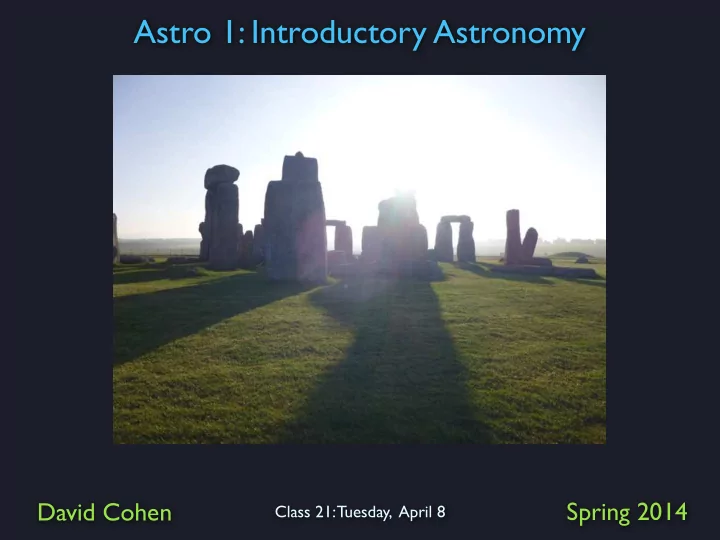

Astro 1: Introductory Astronomy David Cohen Spring 2014 Class 21: Tuesday, April 8
facing east: Moon rising
facing west: Moon setting
Jupiter and Saturn move from night-to-night against the stars looking south East West images taken at (nearly) the same time of night, two weeks apart
Mars looking south East West
In the Copernican model, retrograde motion arises naturally from the dual motion of Earth and Mars.
“The ancient mystery of the planets drove much of the historical debate over Earth’s place in the universe. In many ways the modern technological society we take for granted today can be traced directly to the scientific revolution that began in the quest to explain the strange wanderings of the planets...” (pp. 50-51)
Tycho Brahe’s large sextant (late 1500’s) unprecedented accuracy of star and planet positions (about 1 arc minute)
understanding and predicting the cyclical patterns in the sky was key to the survival of pre-modern, agricultural societies
Early astronomy: marks the cycles of nature…and represents power Limbourg brothers, early 15th Cen.
Ancient people built astronomical observatories to mark the passage of the seasons…and perhaps for more spiritual reasons as well. Stonehenge in England. 4000 years old!
Xunantunich (Maya, 9 th Cen. )
Ancient Greece (6th Cen. BC to 1st Cen. AD) is the primary source of modern astronomy though many of their ideas were wrong, many others were right or at least valuable Starting in the later part of the European renaissance (16th Century), the need to update the Greek astronomical knowledge led to a revolution in astronomy and indeed to the birth of modern science itself
Ancient Greeks developed the geocentric model…a series of nested celestial spheres, with the Earth at the center
Greek astronomy tries to meet the challenge of planetary motion Epicycles – small circles on large circles – allowed for the model to explain complex, non-uniform and non-circular motion…by using “perfect” circles
In Ptolemy’s model, the epicycle moving along the deferent causes retrograde motion (here of Mars)
The Copernican system’s and Ptolemaic system’s explanations of retrograde motion are mathematically equivalent. But the physical causes are very different. see separate powerpoint document with the animations
Recommend
More recommend